What is Taekwondo ? In Korean, you read from top to bottom. Taekwondo is written with 3 signs.

TAE: Stands for all foot and leg techniques both in attack and in defense
KWON: Stands for all hand and fist techniques both in attack and in defense
DO: Literally means the “way”, the “art”. It is accompanied by a certain mental attitude namely: courtesy, integrity, indomitable spirit, perseverance and self-control.
Historical Background
Taekwondo is no ordinary sport, such as football or tennis. It is a martial art. Therefore, there are certain traditions and customs of the ancient Asia (in our case Korea) attached to it, therefore, Taekwondo has a certain philosophy behind it. To better understand for what tae-kwon-do actually stands for, here are some important notes about the origins, history, philosophy and principles of this Korean defense art. In the East, more than one martial art exist, they were originally practiced by monks, farmers, etc., they usually had to defend themselves against attackers with bare hands and feet without weapons. Korea was no exception. One of the Korean “martial arts” was Taek Kyon. From 1909 to 1945, Korea was occupied by Japan. The rulers triedto force Koreans to practice their own martial arts (ex. Judo, karate, etc.), for example, by prohibiting the Korean arts. Even though it was prohibited, Koreans practiced their own arts in secret to maintain the tradition for future generations.
In 1938, Choi Hong Hi (the person who in 1955 will found modern Taekwondo) departed to Japan to study. In two years, he earned a black belt in karate. On his return to Korea, he devoted himself to the liberation of his country, and he was arrested and ended up in a Japanese prison. In 1945, Korea was liberated. Choi became a lieutenant in the Korean army. Increasingly, he realized that Korea had to get back their own martial art. Choi Hong Hi began developing new techniques and late 1954, the foundation for a new Korean martial art was laid down, which was named Taekwondo on April 11, 1955. The spiritual level of Taekwondo is derived from the traditional Korean ethical and moral values.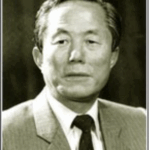
Even if taek kyon and karate were sometimes used as a reference at the physical level, the techniques, based on scientific principles (especially the laws from physics), show that Taekwondo is a different martial art (ex. wave motion and the relationship strength-relaxation).
Meanwhile, Choi became General, so he introduced his sport first into the army. In 1966 (April 22), the International Taekwondo Federation (ITF) was established. As a result of the political pressure and the growing frictions between North and South Korea, General left again his homeland in 1972; he settled in Canada.
In South Korea, WTF (World Taekwondo Federation) was founded in response. Both forms of taekwondo have the same base but they have grown so much apart that the differences are greater than the similarities.
With the evolution of time and the changing needs of society, The General made more adjustments. The ITF Taekwondo was not only under the influence of its founder, it is also an evolving sport too. On June 15, 2002 General Choi died. Master Tran Trieu Quan (VIII degree then) was elected president of ITF
As a summary : Taekwondo was founded in 1955 in Korea by General Choi Hong Hi (09/11/1918 – 15/06/2002), on April 11; it was the first time the name “Taekwondo” was used. ITF was founded in 1966. Tae-kwon-do has approximately 3,200 techniques
Behaviour in the Dojang (CLUB)
Wearing watches, rings, earrings, and etc. is prohibited to avoid injuries.
On entering and leaving the dojang: greetings are mandatory. Greeting is expressed by bowing.
In the dojang, discipline must be followed. The Instructor does not leave the dojang during class unless exceptional circumstances appear.
Why do we greet ?
We salute to show our respect when entering and leaving the dojang and a new training partner.
In competition you also greet at first entering the ring in the beginning or abandoning it in the end.
We never turn our back to higher belts on competition, internships, classes, etc.
Exception : While we correct our dobok, we always turn back.
If we give a hand to someone (training, exam, etc.) we put our left hand under our right hand (knuckles under elbow) out of respect and to show that our both hands are weapon-free.
The tortoise
The turtle is the symbol of Taekwondo. A turtle symbolizes longevity (because she is old), so as the long life of Tae-kwon-do.
She has a hard shell and, therefore, she is protective and comprehensive. All the colors of the belts are built in it.
24 Patterns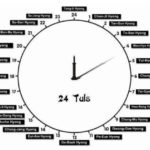
There are 24 patterns (tuls) because the life of a man, perhaps a hundred years,
can be compared with one day (which counts 24 hours) relativing to the eternity. Click on the image to enlarge
Founder Gen. Choi Hong Hi writes: “The pattern represents 24 hours. One day, or all my life. ”
With patterns movements, the taekwondo student set himself an imaginary fight in which both attacking and defensive techniques are used. There are 24 tuls in Taekwondo. The white belt teaches no real Tul, but teaches preparatory movements:
SAJU JIRUGI (4 sides attack) and SAJU MAKGI (4 Sides defense)
Tips
- Pattern must start and end at the same place.
- Always correct posture, position, and composition.
- The muscles of the body are completely relaxed after each movement. During the execution of each movement, the student must control the tension..
- Perform Rhythmic movements not run stiff.
- Both the left and right hand versions equally powerful. Perform each movement with a sense of realism.
- Perform each movement with a sense of realism.
Meaning of the white belt (ti) – 10th Kup
The white belt signifies innocence, like a beginner who has no prior knowledge of Taekwondo.
To know how to correctly tie up a belt, follow instructions in the image.
Formal Titles
1st to 3rd DAN : BOOSABUM (Assistant Instructor)
4th to 6th DAN : SABUM (International Instructor)
7th-8th DAN : SAHYUN (Master)
9th DAN : SASUNG (Grand-Master)
Counting
You have to be able to count to at least 20 in Korean.
| Number | Korean | Number | Korean | Number | Korean |
| 1 | Hana | 11 | Yul Hana | 21 | Seulmoon hana |
| 2 | Dul | 12 | Yul Dul | 22 | Seulmoon dul |
| 3 | Set | 13 | Yul Set | 30 | Soreun |
| 4 | Net | 14 | Yul Net | 40 | Maheun |
| 5 | Dasot | 15 | Yul Dasot | 50 | Sheen |
| 6 | Yasot | 16 | Yul Yasot | 60 | Yesoon |
| 7 | Ilgop | 17 | Yul Ilgop | 70 | Iheun |
| 8 | Yodul | 18 | Yul Yodul | 80 | Yudoon |
| 9 | Ahop | 19 | Yul Ahop | 90 | Aheun |
| 10 | Yul | 20 | Seulmool | 100 | Bak |
Principles/Tenets of Taekwondo (meaning of “do”)
- Courtesy
- Integrity
- Perseverance
- Self-control
- Indomitable spirit
The oath of Taekwondo (Kwaran soon soo)
- I shall observe the tenets of Taekwondo.
- I shall respect my instructors and seniors.
- I shall never misuse taekwondo.
- I shall be champion of freedom and justice.
- I shall build a more peaceful world.
Vocabulary
| Korean | English |
| CHARYOT | Attention |
| KYONG YE | Greet |
| SOGI | Stance |
| MAKGI | Block |
| JIRUGI | Punch |
| CHAGI | Kick |
| JUMBI | Ready |
| SIJAK | Start |
| KUMAN | Stop |
| HAECHYO | Cease |
| SWIYO | Relax |
| DOJANG | Training Place |
| WEN | Left |
| ORUN | Right |
| NAJUNDE | Low |
| KAUNDE | Middle |
| NOPUNDE | High |
| NAERYO | Downward |
| OLLIGI | Upward |
| AP | Forward |
| DWIT | Backward |
| YOP | Sideways |
| BANDAE | Reverse |
| PALMOK | Forearm |
| JOOMUK | Fist |
| SONKAL | Knife-hand |
| HAESAN | End of training |
Hand techniques for 9th Kup
| Korean | English |
| AP JOOMUK BARO JIRUGI | Front forefist middle obverse punch |
| NAJUNDE BAKAT PALMOK BARO MAKGI | Low outer forearm obverse block |
| NADJUNDE SONKAL MAKGI | Low knife-hand block |
| AN PALMOK YOP MAKGI | Inside forearm block |
Positions for 9th Kup
| Korean | English | Picture |
| CHARYOT SOGI | Attention Stance This is the attitude and the movement that one must make when greeting the teacher, a fellow student, the jury and an opponent during competitions :Bend the body 15 degrees forward.Keep looking into the opponent’s eyes. |
Click to enlarge |
| NARANI SOGI | Parallel Stance Spread the feet parallel to the shoulders’ width.The toes need to be pointing forwards.Fists are 5 cm away from each other and on the height of the belt and 7 cm away from the body. |
Click to enlarge |
| GUNNUN SOGI | Walking Stance This is a strong position, both front and rear feet are offensive and defensive.Move one of feet forwards or backwards. The length between both feet should be the length of the shoulders.A stand with a length longer than a one and a half shoulder width makes the movement slow and one is vulnerable to attack from the side, front or back. Bend the front leg so that the heel in a straight aligns with the knee. The rear leg has to be completely stretched.Distribute your body weight equally on both feet. Make sure the toes of the front foot pointing forward. The toes of the back-foot must be pointed 25 degrees outwards When this is more than 25 degrees, the rear leg is more vulnerable to an attack from behind. Tighten the muscles of both feet with the sense to bring them together. Tighten the muscles of both feet with the sense to bring them together. |
Click to enlarge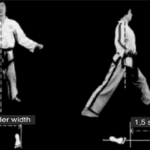 |
| NIUNJA SOGI | L – Stance This position is widely used in the defense, but for the offensive stand also useful.The front foot is in place to give a kick.It only needs a small displacement of body weight to Make a niunja sogi. Move one foot forward or backwards, so that the length between both feet is slightly less than about a shoulder widthThere is pretty much a straight-line corner formed.It is recommended to move both feet to about 15 degrees to point inside, this gives better stability.Bend the back leg until the knee is in a straight vertical line with the toes, ditto the front leg. Make sure that the hip stays in line with the inner knee joint. The body weight distribution is 70 percent on the back leg and 30 percent on the front leg. |
Click to enlarge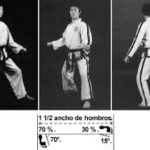 |
| KYONG YE SOGI | Greeting Stance This is the attitude and the movement that one must make when greeting the teacher, a fellow student, the jury and an opponent during competitions :Bend the body 15 degrees forward.Keep looking into the opponent’s eyes. |
Click to enlarge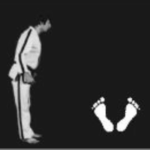 |
